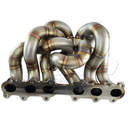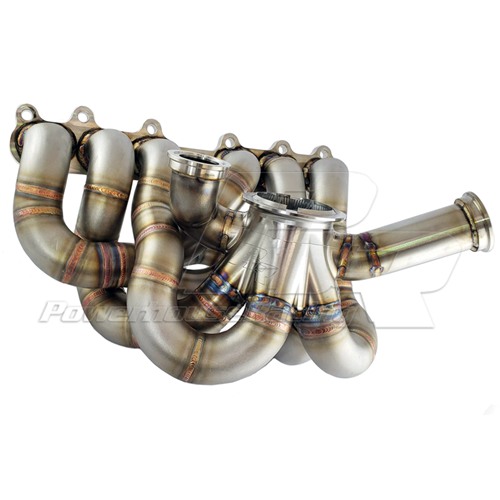PHR V50 Pro Mod Turbo Manifold for 2JZ-GTE
Features and Solutions
Focusing on what's important
The Powerhouse Of Manifolds
Our manifolds are a key piece on some of the fastest and most beautiful cars on the planet. We hope to be a part of yours.
Equal Length Design
The Powerhouse Racing V50 Turbo Manifold features equal length (and equal volume) runner design. This means that the distance from the exhaust port to the turbo is equal between all 6 runners. This not only produces a heavenly exhaust note that you won't find anywhere else, but also increases overall performance.
The even exhaust pulse helps each runner to scavenge the next pulse and provides consistent exhaust pressure throughout the manifold, at the turbine wheel and at the wastegate. You will find this produces higher peak power, better spool, lower exhaust back pressure, and better boost control.

V-band Turbine Housing
Powerhouse Racing is proud to offer our V45 Turbo Manifold for the 2JZ-GTE engine. It's made to support Precision Pro Mod Turbo Manifolds.
23 vs 45 vs 50
You'll notice the second two digits on our manifolds are different (eg: V45 vs V50). What's the difference between the manifolds? Runner size. Below is a chart to help differentiate between manifold runner sizes.
2nd Two Digits | Primary Runner Size |
23 | 1.25 Schedule 10 |
45 | 1.5 Schedule 10 |
50 | 1.5 Schedule 10 |
Runner size is an interesting debate. You can think of this in the same manner as Turbine Housing A/R if you are familiar with it. A smaller runner restricts flow, but increases exhaust gas speed. A larger runner increases flow, but decreases exhaust gas speed. Higher runner flow will result in slightly higher peak horsepower, but slightly slower spool. Lower runner flow will result in slightly lower peak horsepower, but slightly faster spool.
The decision on what works best for you is up to how you plan on using your car. If you are trying to maximize horsepower for your turbo, a larger runner may benefit you. If you want better all around power, a smaller runner may benefit you.
None of our manifolds are poor at making horsepower. Our 23 and 45 turbo manifolds both are rated for the same horsepower. UP to 2000 or more if you have a turbo that can do it! The turbo you choose plays a much larger role in the horsepower you can make. The manifold is often better chosen after you decide what turbo you will use and where you want your performance to be.
Our 50 turbo manifolds are reserved for PRO MOD Drag Race Turbo's and paired with a capable turbo, can produce anywhere from 1500hp to over 3000hp!
Installation
PHR equal length manifolds can be a real pain to install, but we have focused on trying to ease the burden of doing so. We have included short studs for our 2JZ-GTE manifolds and provide a flange nut with a smaller flange to sit next to the runners. We have paid careful attention to the area around the stud to make sure it can seat properly and you can get the necessary tools to the nut.
Fitment
PHR builds the best fitting manifolds. Turbo positioning is ideal. We allow for plenty of room for downpipes, and oil drains, and they fit perfectly under the stock supra hood, even with very large turbos.
Some Details
- PHR S and V Series manifolds use schedule 10 stainless steel tubing. Strong material backed by our lifetime warranty against cracking.
- PHR S and V Series manifolds are hand built in-house by some of the best fabricators on the planet. Pain-staking detail is taken in every inch of these.
-
All TIG welded, Fully back purged, for strength quality and flow. These also eliminates any crystallization (slag). Slag can break off from inside lesser designed manifolds and damage the turbo.
Billet Collector
PHR was the first to use billet collectors on manifolds for the 2JZ. The introduction of the billet collector makes PHR's manifolds, not only the best performing, but also the most beautiful manifolds in the world.
The billet design makes a solid structure at the collection point, so there are no welds after the runner. The Turbo flange is perfectly flat for better seal, and the finish is next to none.
Maximum Performance
PHR manifolds are used by some of the fastest racers in the world. We take price in designing and producing the highest quality and best performing manifolds on the planet. We have manifolds that work well anywhere from 500hp to over 3000hp!
More than just a manifold
We include more than just a manifold when you get a PHR V50.
 Short Stud and Nut Kit
Short Stud and Nut Kit
If you've ever installed a turbo manifold on the 2JZ-GTE, you understand the pain it can be. The factory studs were designed with the stock sequential turbos in mind and therefore are not ideal to use with a tubular manifold. They are way too long and become a huge problem when installing a manifold.
PHR remedies the problem by providing our Short Stud and Nut Kit, which features Grade 12.9 Studs, so not only are they shorter, they are much stronger than OEM. The flange nuts also have a smaller diameter flange which allow them to fit better next to the tubular runners.
 Lower Waterneck Adapter (Rotator)
Lower Waterneck Adapter (Rotator)
The lower waterneck rotator, rotates your waterneck downward, and away from the turbo manifold, giving you extra room you need to install the turbo manifold and turbo. These are essential for clean installs without extra work or welding to get the turbo, manifold or intercooler piping fit properly.

Boost Control
Advertised spring pressure does not always follow real world turbo outlet pressures. Several factors will affect the wastegate openening pressure. Mostly it's pressure on the bottom of the diaphragm and pressure on the bottom of the valve. Pressure on the bottom of the diaphragm is easy, it's really just turbo compressor outlet pressure. Pressure on the bottom of the valve is more complicated.
Manifold design, turbo sizing, turbine size and Turbine housing A/R directly effect pressure on the bottom of the valve. These can all effect exhaust manifold pressure, not only at the turbo but at the gate as well. You can get different pressures in the collector of the manifold and at the bottom of the valve, but in general, they should be fairly close to the same, but even 1 or 2 psi will have an effect. With all of those factors added in, you cannot assume the advertised spring pressure will output actual advertised boost pressure.
A very well designed manifold/turbo combination may produce significantly less exhaust back pressure, which will increase the turbo compressor outlet pressure compared to advertised spring pressure.
All this told, the advertised spring pressure is a good guideline, but the springs will need to be adjusted depending on what testing results we get. Typical Pressure on the PHR Manifolds are usually 5 psi above advertised is what we usually see on Tial wastegates. If you wants lower pressure, say 14, you may need to put a 9 or 10 psi spring combination in.
The most important thing is not what is the advertised spring, but are you able to control the boost to what you want. As long as you are not boost creeping, the wastegates are doing their job.
Specifications
| Vehicle Fitment | |
|---|---|
| Make | Toyota, Lexus |
| Model | Supra, SC300 (Soarer), IS300 (Altezza), GS300 (Aristo) |
| Chassis Code | A80, Z30, Z31, Z32, S160, S161, S147, CE10, XE10 |
| Generation | MKIV (Mark 4), 1st Gen, 2nd Gen |
| Fitment | |
|---|---|
| Engine | 2JZ-GTE, Non VVT-i, 2JZ-GTE, VVT-i |
| Turbo Fitment | Precision Pro Mod |
| Product Specs | |
|---|---|
| Material | Stainless steel |
| Primary Tubing Size | 1.5 Schedule 10 |
| Horsepower Rating | 1500-3000 |
| Primary Tubing Outer Diameter | 1.9" |
| Primary Tubing Inner Diameter | 1.682" |
| Tubing Material | Schedule 10 Stainless |
| Flange Material | Stainless Steel |
| Variants | |
|---|---|
| Number of wastegates | (S) Single wastegate or (D) Dual wastegate |
| Wastegate Flange(s) | Turbosmart 60mm or TiAL 60mm or Precision 56mm or Dual Gate 44, 45 or 46mm |
| Collector | Billet |
| Turbo Scroll | Single Scroll |





